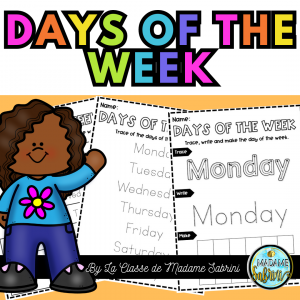This post may contain affiliate links which means I may receive a commission for purchases made through links. I will only recommend products that I have personally used! Learn more on my Private Policy page.
As a teacher, learning to spot ADHD in your classroom can be a challenge. But with a little knowledge and the right approach, you can create an environment that is tailored to the unique needs of ADHD students. With the ABCs of Spotting ADHD in the Classroom, you will learn how to recognize the signs of Attention Deficit Hyperactivity Disorder and show your students the love and care they need.
What is ADHD and how does it affect children in the classroom?
ADHD, or Attention Deficit Hyperactivity Disorder, is a neurodevelopmental disorder that affects approximately 6-9% of school-aged children. Children with ADHD have difficulties with attention, hyperactivity, and impulsivity. These difficulties can have a significant impact on their academic performance and behavior in the classroom.
In the classroom, students with ADHD may have trouble staying focused on tasks or instructions from the teacher. They may also have difficulty sitting still and remaining quiet during class. This can disrupt the learning environment for both the student with ADHD and their classmates.
Teachers can adapt their teaching methods and classroom environment to help support students with ADHD. For example, breaking down instructions into smaller steps and providing more frequent feedback can help keep students engaged and on-task. Modifying seating arrangements to reduce distractions or providing a designated space for movement breaks can also be effective accommodations.
It’s important for teachers to understand that ADHD is a medical condition and requires proper diagnosis and treatment. Communication with parents and healthcare professionals is crucial for creating a plan that addresses the specific needs of the student with ADHD in the classroom. By working together, teachers and support staff can provide the best possible learning environment for all students.

Common behaviors exhibited by children with ADHD in the classroom
It can be difficult to spot ADHD in the classroom, as the symptoms of the disorder can sometimes be mistaken for typical child behavior. However, there are a few common behaviors that students with ADHD often exhibit. These behaviors include difficulty paying attention, impulsiveness, hyperactivity, and forgetfulness.
In the classroom, a student with ADHD may have trouble sitting still and focusing on a task for an extended period of time. They may be easily distracted by external stimuli, such as noises or movements around them. This can make it challenging for the teacher to keep their attention during lectures or group discussions.
Students with ADHD may also struggle with impulsiveness. They may interrupt the teacher or other students during class, and may have difficulty waiting their turn to speak or complete a task. Additionally, forgetfulness is a common symptom of ADHD, and students may forget assignments or fail to bring necessary materials to class.
It is important for teachers to be aware of these behaviors so that they can adapt their teaching methods to better support students with ADHD. Strategies such as providing frequent breaks, breaking down assignments into smaller tasks, and providing clear expectations and reminders can all help students with ADHD better manage their symptoms in the classroom.

Strategies for identifying and tracking ADHD symptoms
As a teacher, it can be challenging to identify students with ADHD in the classroom. However, there are several strategies you can use to track and observe symptoms of ADHD to better understand and support your students.
First, it’s important to create a learning environment that can adapt to the needs of all students. This can include creating a structured routine, minimizing distractions, and offering flexible seating options. When students are comfortable and engaged in their learning environment, it’s easier to observe their behavior and identify potential symptoms of ADHD.
Another effective strategy is to create a tracking system for behaviors associated with ADHD. This can include keeping a daily log of behaviors that disrupt the classroom, such as interrupting or fidgeting. This can help teachers and parents understand patterns of behavior and work together to develop strategies for managing symptoms.
Additionally, communication with parents and healthcare professionals can be critical in identifying and tracking ADHD symptoms. Collaborating with parents and healthcare providers can provide insight into a child’s behavior and any treatment they may be receiving.
Finally, it’s important for teachers to be knowledgeable about the common behaviors associated with ADHD. This can include inattention, impulsivity, and hyperactivity. Understanding these behaviors can help teachers recognize symptoms and respond appropriately to support their students.
By implementing these strategies, teachers can more effectively identify and track symptoms of ADHD in the classroom. This can lead to more targeted interventions and support for students with ADHD, improving their overall learning experience.

Communication with parents and healthcare professionals
Effective communication between teachers, parents, and healthcare professionals is crucial for identifying and supporting students with ADHD in the classroom. Parents are often the first to notice symptoms of ADHD in their child and can provide valuable insight into their child’s behavior both inside and outside the classroom.
It’s important for teachers to have open and honest communication with parents about their child’s behavior and any concerns they may have about ADHD. Teachers can also provide feedback to parents on their child’s progress in the classroom and any strategies that have been successful in managing ADHD symptoms.
Healthcare professionals, such as pediatricians and psychologists, can provide valuable information and support for teachers and parents in managing ADHD. They can provide diagnosis and treatment recommendations and work with teachers to adapt the classroom environment to better support students with ADHD.
Working together, teachers, parents, and healthcare professionals can create a supportive and effective learning environment for students with ADHD. Communication and collaboration are key to adapting classroom strategies and interventions that meet the unique needs of each student with ADHD.

Classroom accommodations and interventions for children with ADHD
One of the keys to supporting students with ADHD is to adapt the classroom environment to meet their needs. Here are some ideas for classroom accommodations and interventions:
1. Provide clear structure and routines: Students with ADHD benefit from a predictable, consistent schedule. Use to help them stay on track and understand what’s coming next.
2. Use multisensory approaches: Engage students in hands-on learning experiences that involve different senses, such as visual, auditory, and kinesthetic. For example, use manipulatives or games to teach math concepts.
3. Break tasks into smaller steps: Large tasks can be overwhelming for students with ADHD. Help them break down assignments into smaller, more manageable steps. This will also help them stay focused and on-task.
4. Offer frequent breaks: Students with ADHD often struggle with attention and focus. Offer frequent breaks to allow them to move around, stretch, or take a few deep breaths. This can help them recharge and stay engaged.
5. Allow for movement: Many students with ADHD benefit from movement breaks or opportunities to move around the classroom. Consider incorporating movement into lessons, such as having students act out a scene from a story or doing a group dance to review vocabulary.
6. Provide feedback and positive reinforcement: Students with ADHD may struggle with self-regulation and impulse control. Provide frequent feedback on their behavior and work, and use positive reinforcement to encourage them to stay on-task and make good choices.
Remember that each student with ADHD is unique, and may require different accommodations and interventions. Work closely with the student, their parents, and healthcare professionals to determine the best approach for supporting their learning in the classroom. With patience, understanding, and flexibility, you can help your students with ADHD thrive in the classroom.
Collaboration with teachers, support staff, and administration for effective support of students with ADHD
Collaboration is essential in supporting students with ADHD. It’s important that teachers, support staff, and administration work together to create a classroom environment that is conducive to learning and adapt to the unique needs of each student.
Teachers play a crucial role in identifying and monitoring the behavior of students with ADHD in the classroom. By sharing observations with support staff and administration, they can work together to create individualized plans for each student.
Support staff can provide valuable assistance to students with ADHD in the classroom. They can help the teacher to develop effective strategies and accommodations, such as providing fidget toys or breaking tasks down into smaller steps, that will help students with ADHD to be successful in their learning.
Administrators can ensure that policies and practices in the classroom are consistent with the needs of students with ADHD. They can help to provide resources and training to teachers and support staff, and create an overall culture of understanding and support for students with ADHD.
By collaborating effectively, teachers, support staff, and administration can help students with ADHD to thrive in the classroom. They can create a supportive environment that promotes success and helps each student to achieve their full potential.
















1 Comment
I like this website it’s a master piece! Glad I discovered this!